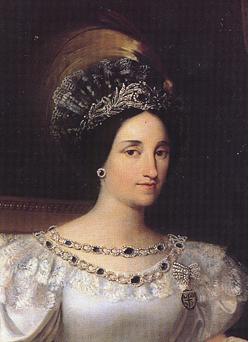 |
 |
 |
 |
 |
 |
 |
 |
 |
Mary III and II
From her birth Mary Beatrice bore the title of "Princess of Savoy". When she was born, Marie Beatrice was also third in line to the English and Scottish thrones - after her uncle King Charles Emanuel IV of Sardinia and her father. Mary Beatrice grew up during the troublesome years of the French Revolution and the Bonapartist campaigns throughout Europe. In December 1798 she fled from Turin with her parents and uncles. The family went first to Parma and then to Florence. In February 1799 they sought refuge on the island of Sardinia (the only part of her uncle Charles Emanuel's dominions which he had been able to retain). Mary Beatrice spent most of the next thirteen years living in the city of Cagliari in Sardinia. On June 20, 1812, in the cathedral of Cagliari Mary Beatrice married her uncle, Archduke Francis of Austria, eldest son of Archduke Ferdinand Charles of Austria, Duke of Breisgau, and of his wife, Princess Maria Beatrice Este; a special dispensation for the marriage was received from the Holy See. The couple had four children:
Mary Beatrice and her husband remained on the island of Sardinia until July 15, 1813 when they sailed to the Greek island of Zakinthos (Zante). From there they sailed up the eastern shore of the Adriatic Sea to Trieste, and then travelled by land to Vienna. On July 14, 1814, Mary Beatrice's husband, Francis, became Duke Francis IV of Modena, Reggio, and Mirandola; he was the grandson of the last Este duke of Modena Ercole III. From this time forward, Mary Beatrice used the title "Duchess of Modena". Mary Beatrice and her husband fled from Modena during the Hundred Days when the armies of Joachim Murat invaded the duchy, but they returned May 15, 1815. At the death of her uncle Charles Emanuel, October 6, 1819, Mary Beatrice's father Victor Emanuel succeeded to all of his British rights. Mary Beatrice was henceforward recognised by the Jacobites as "The Princess Mary of England, Scotland, France, and Ireland". At the death of her father Victor Emanuel, January 10, 1824, Mary Beatrice succeeded to all of his British rights. She was henceforward recognised by the Jacobites as "Queen Mary III and II". She was the first queen regnant since Queen Mary II Stuart who was assassinated in 1587. Mary Beatrice is called "Queen Mary II" by those Jacobites who do not number Mary Stuart as Mary II of England. On February 5, 1831 Mary Beatrice and her family had to flee Modena owing to the outbreak of a revolution. With the support of the Austrian military, however, they were able to return within the year. Mary Beatrice died of a heart condition at the villa of Catajo, September 15, 1840, when she was succeeded in her British rights by her elder son Francis. Her remains lie in the Chiesa di San Vincenzo in Modena. Mary Beatrice was a Lady of the (Austrian) Order of the Starry Cross.
This page is maintained by Noel S. McFerran (noel.mcferran@rogers.com) and was last updated July 31, 2007. © Noel S. McFerran 2003-2007. |
